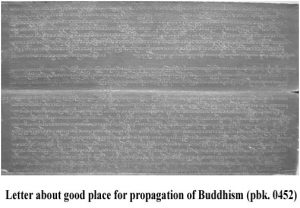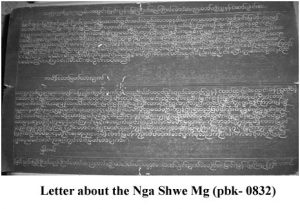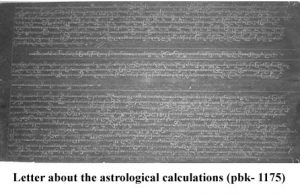Admitted letters of Konbaung period in Parabike Manuscripts
Ni Ni Naing
Librarian
Universities’ Central Library
Universities’ Central Library started to collect old manuscripts since the 1960s, sending groups of librarians to many monasteries all over Myanmar. There are over 4000 folds, collected from donations or by purchasing.
There are mainly two kinds of parabikes: white and black. The white parabikes are mostly to draw colorful painting or Yaung zon parabike. The black parabikes are made from hand-made paper. Parabike are made out of the Maing Kaing paper, a kind of coars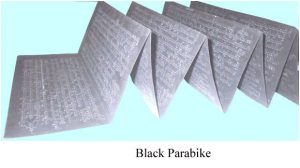 e paper handmade from mulberry pulp in Maing Kaing town in Shan State. They were classified according to the number of folds ranging from a single fold to 64 folds.
e paper handmade from mulberry pulp in Maing Kaing town in Shan State. They were classified according to the number of folds ranging from a single fold to 64 folds.
The black parabikes contain many subject matters and events. Black parabikes were records kept by individuals and families for financial transactions, agricultural records, day-to-day accounts, medicinal formu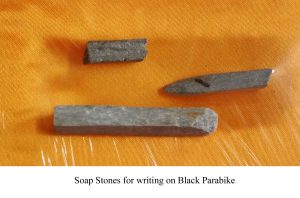 las, cooking recipes, short poems and diaries, administration, history, economy, astrology and mainly used as note-book for writing drafts. The Size of Parabike Manuscripts are usually within this range: length of 17 or 18 inches and width of 7 or 8 inches. Very small parabikes have the length of about 3 inches and the width of 1.5 inches. A soap stone or steatite is used as a writing stylus on black parabike.
las, cooking recipes, short poems and diaries, administration, history, economy, astrology and mainly used as note-book for writing drafts. The Size of Parabike Manuscripts are usually within this range: length of 17 or 18 inches and width of 7 or 8 inches. Very small parabikes have the length of about 3 inches and the width of 1.5 inches. A soap stone or steatite is used as a writing stylus on black parabike.
This paper expresses the letters writing forms and events happened in Konbaung era from (ME 1230-1330) (AD 1868- 1968). There are many kinds of correspondent letters such as: informed letter (ၾကားစာ), admitted letter (သြင္းစာ), note (မွတ္စာ), memorandum (မွာစာ), summon (ဆင့္စာ) and love letter (ေမတၱာစာ) and so on, but admitted letters (သြင္းစာ) differ from royal order and found in many social life events. So, study of the collected data was to be regarded as a reliable reference for researchers and those interested in ancient Myanmar manuscripts.
Admitted letter is an order of authoritative group or person in a parliament, and it is considered a higher letter because Wun Min (ဝန္မင္း), Gaing Gyoke (ဂိုဏ္းခ်ဳပ္) (Head of Monastic Association Belonging to a religious sect), Gaing Oak (ဂိုဏ္းအုပ္)( Head of an Association of a religious sect as well as Association to a religious sect), Gaing Htauk (ဂိုဏ္းေထာက္),(Association to head of an association of a religious sect) can directly admit the letters to the king.
There are (65) admitted letters out of (346) correspondent letters from the black parabikes, categorized mainly as administration, religious affairs, astrology, economics and taxation. In analyzing, out of the (65) admitted letters, there were (28) records for administration, (2) records for astrology, (5) records for economy, (18) records for religious affairs and (12) records for taxation. Among them, the most records were from the administration and the least records were from astrology.
Among (65) admitted lette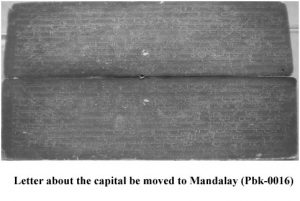 rs, I would like to present some interesting admitted letters in this paper.
rs, I would like to present some interesting admitted letters in this paper.
Admitted letters about administration are letters submitted by Tilawkadaza Sayadaw to the head of religious sect saying that “a new capital city should be moved from Amarapura to Mandalay”
Another admitted letter is from the Brahmins to his kings, saying that the construction of Mandalay palace should be constructed in ME 1221.
In ME 1215, admitted letter, claiming that the capital of Amarapura had traditionally been a good place for propagation of Buddhism, was admitted by Sayadaw to Ruler of the State.
In ME 1238, the letter suggesting that “the rebellious acts of Nga Shwe Mg who was headman in Myinkun city got permission to live with his family in their village” was admitted by the Head of the religious sect to His Majesty.
And also another letter was admitted by the Head of the Religious Sect to His Majesty saying that “More investigation should be made on Nge Shwe Mg for his participation in the rebellion”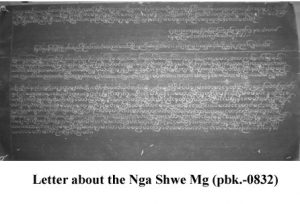
In ME 1235, letter saying that “governors of the town and King’s servants were working lawfully for the peace and order of the town” was admitted by the Head of the Religious Sect to His Majesty.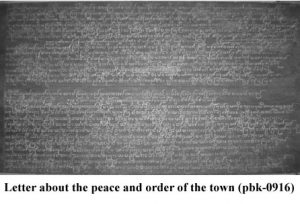
An example of a letter about astrology is: in ME 1218, letter about “events in the past and what was likely to happen in the future according to the astrological calculations” was admitted by Sagaing Sayadaw to the King.
And then, an example of a letter about economy is: in ME 1237, a letter asking to solve the problem “of neither being able to make Shar Say (could not boil cutch) nor buy them in the village” was admitted by the head of the Association of Religious Sect to His Majesty.
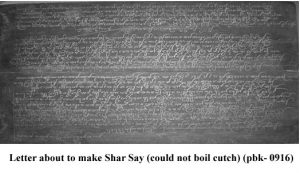 Another letter is about the religious affairs: in ME 1234, letter stating that “the monks were serving the Sasana in accordance with the virtues and discipline indicated by the rules and regulations of Sudhamma Sayadaw” was admitted by the Head of the Religious Sect to His Majesty.
Another letter is about the religious affairs: in ME 1234, letter stating that “the monks were serving the Sasana in accordance with the virtues and discipline indicated by the rules and regulations of Sudhamma Sayadaw” was admitted by the Head of the Religious Sect to His Majesty.
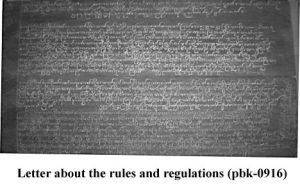
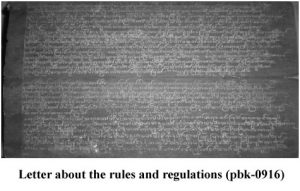 In addition, another letter about receiving the monthly donation materials such as gold, silver candle-sticks from His Majesty was admitted by the Head of the Religious Sect to His Majesty.
In addition, another letter about receiving the monthly donation materials such as gold, silver candle-sticks from His Majesty was admitted by the Head of the Religious Sect to His Majesty.
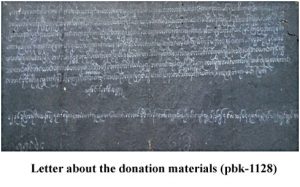 The last admitted letter is about Taxation (Tax for ten tithe given to King): In ME 1232, the letter about poor people running away from their villages because they were not able to pay their tax, keeping the rest of the family members worried, was admitted by the head of the Religious Sect to His Majesty.
The last admitted letter is about Taxation (Tax for ten tithe given to King): In ME 1232, the letter about poor people running away from their villages because they were not able to pay their tax, keeping the rest of the family members worried, was admitted by the head of the Religious Sect to His Majesty.
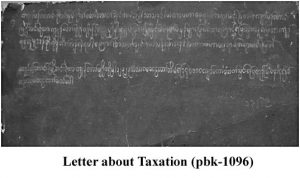 In ME 1233, a letter was admitted by the Ruler of the state to the King saying that the tax collectors were capturing and torturing the poor people and headmen of village.
In ME 1233, a letter was admitted by the Ruler of the state to the King saying that the tax collectors were capturing and torturing the poor people and headmen of village.
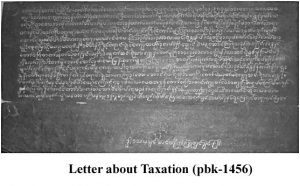 This letter was admitted in ME 1235 by the Head of the Religious Sect to his King saying that “the common people were too poor to pay the taxes so that the King would allow them to postpone paying taxes for several months”
This letter was admitted in ME 1235 by the Head of the Religious Sect to his King saying that “the common people were too poor to pay the taxes so that the King would allow them to postpone paying taxes for several months”
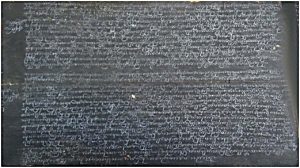 Letter about Capturing and Torturing the poor people (pbk-1456)
Letter about Capturing and Torturing the poor people (pbk-1456)
In conclusion, there are different kinds of letters and, among them, I have presented selected admitted letters in Konbaung period about Administration, astrology, economy, religious affairs and taxation. These admitted letters were to the King from the head of the Religious Sect. According to these studies, we know ancient Myanmar writings, and the situations of Konbaung period.
It can help the users to find events concerning with administration, religious affairs, economy and taxation of Konbaung period. It will be useful for historians and scholars who are interested in Myanmar history and administration of ancient Myanmar Kings.
BIBLIOGRAPHY
- La Pye Win Htun, Ma. A Study on the Summons Recorded in Parabaik from the Collections of Universities’ Central Library. M.A Thesis, Department of Library and Information Studies, Yangon University, Myanmar, 2013.
- Mg Mg Thein, U. Pay Parabaik Myatnhar Byin Paw Mha Lay Lar Twe Shi Chat Mya. Yangon: Sarpay Beikman Press, 2003. p. 3.
- Myanmar Historical Commission, Selection Writings of U Thaw Kaung. Yangon: Yangon Universities Press, 2004.
- Soe Thanda Win, Ma. A Study on Admitted letter recorded on parabike collected at the Universities’ Central Library. M.A Thesis, Department of Library and Information Studies, Yangon University, Myanmar, 2014.
- Thaw Kaung, U. From the Librarian’s Window: view of library &
Manuscripts Studies and Myanmar Literature. Yangon: Myanmar Book Centre, 2008.


